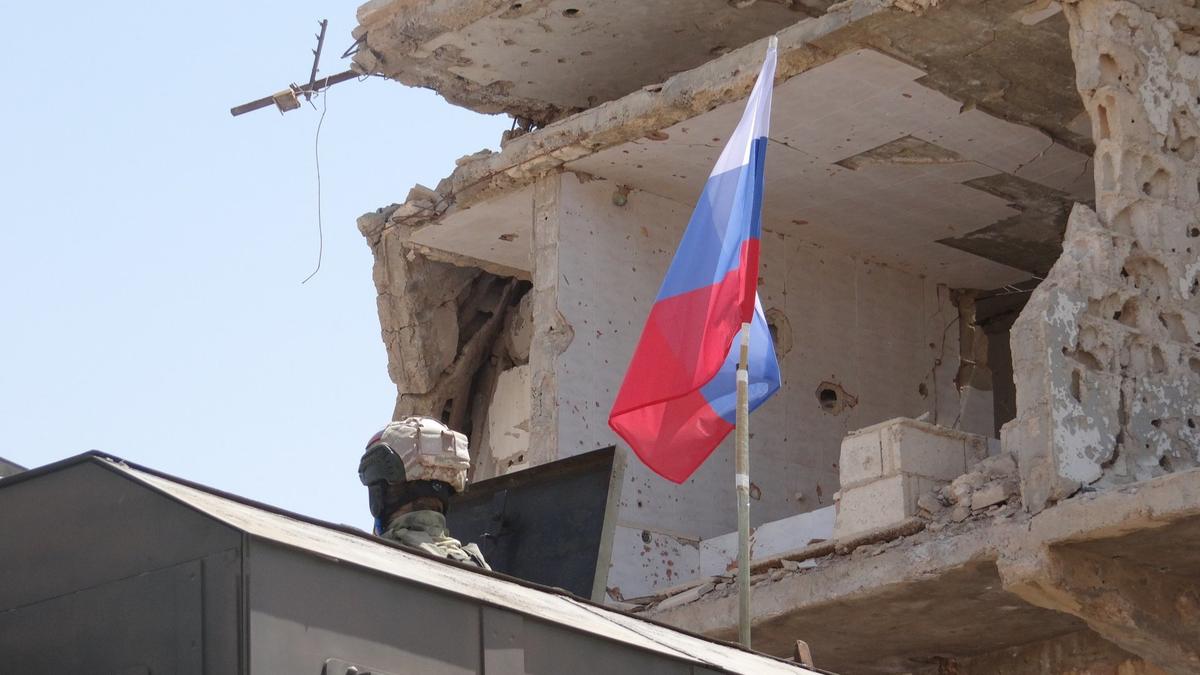Hmeimim Air Base is often described as “a state within a state”. Around 20,000 Russian soldiers are stationed here. Russia has possibly spent more than $5 billion for base upkeep since 2016. It is an important hub particularly for the notorious Wagner Group which was used to dispatch mercenaries to Ukraine and other hot spots around the world.
Meanwhile, thousands of locals live right next to the air base. Russian jets on average have been making 457 flights a day from Hmeimim since the war broke out in Syria, which leads to health-damaging noise levels, periodically dropping shells, and cracked building walls. Moreover, local farmers are suffering from extortion by military personnel and cannot get to their lands due to constant checks.
Syria Indicator investigative project joined forces with Novaya Gazeta Europe to tell the story of Russia’s largest overseas military base and the people living around it.
This is a slightly edited version of the article originally published by Syria Indicator.
As you visit the Syrian coast near Jableh, and whatever direction you take, whether through Qardaha road or the second Jableh bridge on the international road (Latakia-Tartous highway), be careful! You are near Hmeimim, the Russian air base known today as “A state within a state.”
Military intelligence and state security checkpoints surround the area. At each checkpoint, you need to show your identity card and answer crucial questions: What is your destination? What is the name of the person you are going to visit, their occupation, and exact place of residence? Failure to answer exposes the person to be arrested.
None of the residents or even state employees dare to criticise the existence of the airbase in public. The conversations remain underground, especially those related to the agreement to hand over the base to the Russians, its annexes, and its legal impact.
The story from the beginning
Until recent years, Hmeimim was a small, unknown town four kilometres northwest of Jableh in the Latakia Governorate. In 1956, a law was issued to establish Hmeimim Airport, officially known as Latakia International Airport (LTK, OSLK) before it changed to the Martyr Basil Hafez Al-Assad Airport in 1995.
After the Russian forces flowed into Syria in the summer of 2015, they chose the airport and part of the surrounding areas as the headquarters for their base. The name Hmeimim became the focus of global attention as the first Russian base to be built in the Middle East, and the first and largest foreign military base in Syria, equipped with many recent military technologies and weapons.
On 26 August 2015, an agreement was concluded between Russia and Syria to establish a base in Syria for an indefinite period to be exploited by the Russian armed forces, according to the Treaty of Friendship and Cooperation between the Soviet Union and the Syrian Arab Republic signed on October 8, 1980.
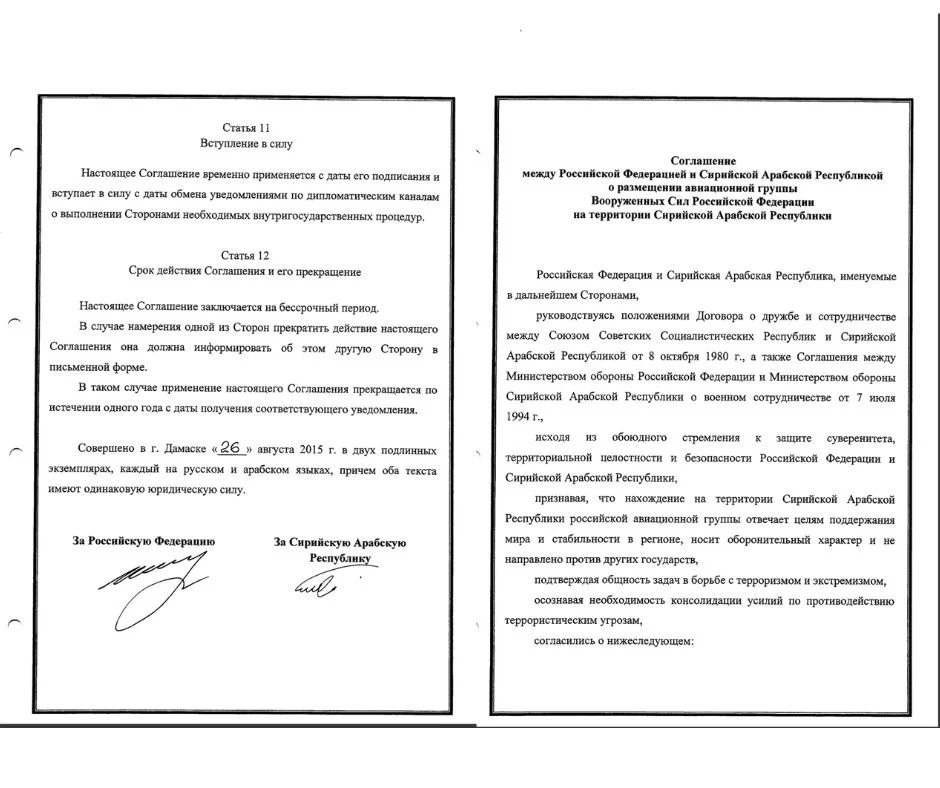
The first and last pages of the agreement protocol between Syria and Russia regarding the deployment of an aviation group of the Russian Armed Forces on Syrian territory, August 26, 2015, signed by the Russian Defence Minister Sergey Shoigu and his Syrian counterpart Fahd Jassem Al-Freij. Source: Official website of legal documents of the Russian Federation (a Russian state institution)
Two years later, based on the previous agreement, the Kremlin signed a new long-term lease for the base with Damascus for a period of forty-nine years, automatically extended for subsequent periods of 25 years. Accordingly, the plot of land on which the airport is built is transferred to Russian ownership for the duration of the contract.
The signing of the agreement to transfer the land of Hmeimim to Russian ownership coincided with another agreement, which also included Russia’s exploitation of the port of Tartous in the south to establish a naval base. The signing of the lease agreement was accompanied by great confusion that it was donated by Damascus to Russia without any financial consideration or an official explanation from the latter.
The base extends to the west
On 24 April 2020, a new agreement was signed based on Protocol No 1, which was inked in 2015. This agreement stipulates the transfer of a plot of land with a water area on the Syrian coast, in Latakia Governorate, opposite the Hmeimim Air Base, for the Russians “to establish and host a health medical centre and rehabilitate a group of Russian aviation (Hmeimim base)”. According to the terms of the new contract, Russia can remove real estate and buildings and carry out engineering operations according to its terms.
The new area mentioned in the agreement is eight hectares (80,000 square meters). It extends in the water and on the shore at a depth of 65 to 150 meters, bearing in mind that the text contained secret appendices about plans and a graph supported by coordinates, thus defining the area accurately.
Some residents speculate about the nature of the marine area that the Russians will seize after the agreement on 30 April 2020.
An environmental activist, who asked that his name remains anonymous, indicates that the marine plot will be on the sandy beach separating the south of Latakia and the north of Jableh, or what is known as Shaqaifat Beach. It means that the security measures will negatively affect the coastal residents in the villages extending into that area, and this includes economic damage, and what is equivalent to environmental damage, given that it constitutes a habitat for sea turtles. The construction and buildings, such as clubs and medical centres, will leave an environmental impact that increases the dangers to turtles, whose nesting rate in the area has decreased due to tampering, pollution, and sand eroding.
Via inspection and satellites, a group of investigators monitored the sea area opposite the base along the coast of Latakia. They did not notice any vehicles or construction in the area in general or in the opposite sea area in particular.
Expansion and improvements
After taking control of the airport, Russia expanded it to receive more military and civilian aircraft.
As of 2015, large parts of the facility have either been effectively rebuilt or significantly improved, including expanded helicopter facilities, supporting infrastructure, and air and sea defences.
The base has become an intermediate staging ground for MiG-29 Fulcrum fighters and Su-24 Fencer combat aircraft that Russia has sent to Libya to reinforce and support forces allied with General Khalifa Haftar.
The expansion operations at the base included the addition of a ramp of 76 square meters with direct access to the eastern runway, completed in 2016, in addition to a row of fortified aircraft shelters in the northwest corner of the facility built between 2018 and 2019 to respond to the threat of aircraft attacks, drones, and other indirect firearms.
Later, the satellites captured pictures showing the expansion of one of the main runways at the Hmeimim base (the western runway), which would increase the base capacity and facilitate logistical and strategic transfers for the Russians in the Middle East.
The Drive, a website specialising in war and defence affairs, published the photos in February 2021, stating that they indicate the Russians have added about 300 meters to the western runway at the air base, extending its total length to 3,200 metres, compared to about 2,900 metres previously.
It was not a hidden matter, as Russian Defence Minister Sergey Shoigu said in an expanded meeting of the Presidium of the Russian Ministry of Defence on 12 February 2021, that “work has been completed to increase the length of the western runway in this military site”.
The expansion process includes the western runway, and it took place on the north-western side towards the village of Batra in the town of Hmeimim. The investigation monitored, via satellite images, the area of expanding the runway north and south.
The expansion did not take place outside the airport campus, as much as it was a process of arranging the airport itself to make it more spacious and accommodating.
Transfer of arms and mercenaries
Since 2015, the Hmeimim Air Base has also been used to deliver the mercenaries of the Wagner Group not only to Syria in order to participate in the battles on the side of Bashar al-Assad but also in Libya, Sudan, and Central Africa. Moreover, Hmeimim is used to transport mercenaries to Ukraine to fight alongside the Russian forces and the separatists.
In addition to the military units IL-76 and IL-62 of the Russian Ministry of Defence, which delivered equipment to equip the base, personnel, and soldiers, the Syrian Cham Wings Airlines company transported mercenaries to the Hmeimim base.
Since the beginning of 2017, this company has carried out more than 50 flights from Rostov Airport Platov (the civil airport is in the same area as the base of the Russian Aerospace Forces) to Latakia and Damascus.
Reuters quoted witnesses saying that Cham Wings carried out flights to transport mercenary fighters using Airbus A320 aircraft with a capacity of up to 180 passengers.
The number of mercenaries that the company transferred to Damascus and Latakia was about 9,000.
The Russians took advantage of the presence of the civilian airport (Latakia) adjacent to the Hmeimim military air base in operations to transport soldiers and weapons.
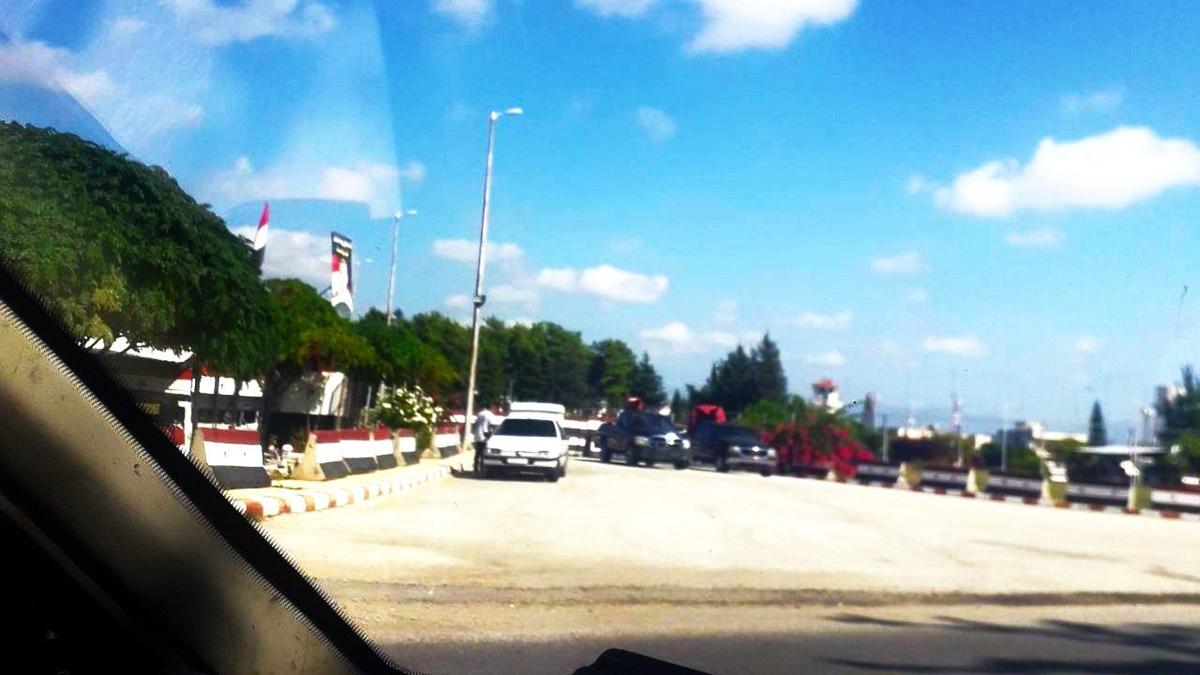
Entrance to Latakia Civil Airport, adjacent to Hmeimim Air Base.
Exclusive: Syria Indicator
According to several members of the Wagner Group, the port of Tartous was invested in mercenaries arriving on board the large landing ships of the Russian Navy.
For example, the floating cargo carrier Kazan-60 was used. It travelled between Russia and Syria, and the Russian army brought it after the Russian company ASP of Wagner leader Yevgeny Prigozhin.
Since August 2018, two Tu-154M aircraft of the Russian Air Force, No. 223 Squadron, leased by private companies, have flown regularly between the Hmeimim base, the Sudanese capital, Khartoum, the Libyan city of Benghazi, and the Central African capital, Bangui, according to the data of the devices of Ukrainian security. At a time when reports showed the activity of Russian mercenaries in these countries, and through companies including M Invest linked to businessman Yevgeny Prigozhin, according to RFE/RL.
Hmeimim: a centre for transporting mercenaries to Ukraine
Documented information indicates that the Hmeimim base was a central station for transporting Wagner mercenaries to Ukraine to fight alongside Russian forces and separatists on more than one front.
Recently, Syrians for Truth and Justice monitored three flights, two of them via Hmeimim, during which about 300 fighters were transported from Syria to Ukraine between June and September 2022.
Witnesses from the families of the transferred soldiers said that a security company called Al-Sayyad informed them that the soldiers were killed there without handing over bodies or official papers proving the death.
The last three flights are part of a series of transfers of Syrian mercenaries from Libya and Syria to fight in Ukraine.
FlightRadar24 crossed the testimonies and monitored the flights after that. The data showed that the first two flights (on an Ilyushin Il-76 aircraft, carrying registration number RA-78840), and the second (on an Antonov An-124 aircraft, registration number RA-82038), took place on 5 June and 7 July 2022, and both flew from Syria to Russia via Hmeimim.
The third flight took off from Aleppo (northern Syria) to Tehran on 9 September 2022, before transporting soldiers on a second flight from Tehran to Russia two days later.
Russians steal electricity
The people of the region joke about the Hmeimim base by calling it Al-Madinah Al-Munawwarah (the second holiest city in Islam after Mecca — Novaya-Europe) or the White House, indicating that the electricity to the building is never cut off, despite the fuel crisis and rationing in the country.
Article 13, Clause 3 of the protocol attached to the 2015 agreement, signed on 18 January 2017, reads: “The Syrian party shall take appropriate measures for the continuous supply of the Russian aviation group, including residential buildings intended for the residence of the employees of the Russian aviation group and the families of the members of the Russian aviation group, as well as social facilities, cultural facilities, social welfare, canals, wired communication lines, provision of electricity, water and other types of public services, under the standards in force in the Syrian Arab Republic, free of charge until 31 December 2017.”
The clause states: “As of January 1, 2018, these services will be provided by the Syrian party on a contractual basis.” This means that there will be contracts for supplying water and electricity between Damascus and Moscow in this regard.
During the years that followed the deadline, supplying electricity continued, but no contracting process or charging for the price of electricity took place. The investigation confirmed this after reviewing the Electricity Directorate in Latakia, as no documents or meters related to the base have been found.
One of the specialised employees of the Directorate confirmed that the period between 1 January 2018 and August 2022 (the date on which the Directorate was reviewed) did not witness any payments in exchange for drawing electricity to the Hmeimim military airbase.
Asking one of the collection employees and another in the contracts department in the Latakia Electricity Directorate, both denied the existence of any invoices addressed to the base. One of the employees indicated that such invoices are sent to the Ministry of Electricity, which directs them to other parties.
The matter necessitated Syria Indicator to ask questions to the Syrian Ministry of Electricity to confirm the existence of contracts or a collection process for the electricity drawn by the Hmeimim base. However, the Ministry did not respond or provide any clarifications until the date of publication of this investigation.
Eng. Khaled (a pseudonym for security reasons) says the base consumes one megawatt/hour. Considering that the tools and equipment in there use most of the regular electric current of 220 amperes (available in the public network) and operate 24 hours a day, the cooling and heating systems in some of them increase consumption; air monitoring systems also consume more energy.
He estimated the value of the electricity consumed at the base at more than 1.1 billion SL per year according to the commercial segment or the temporary meters.
According to the Ministry of Electricity price, the average price of a kilowatt-hour for this segment is about 127 SL (as of the beginning of November 2021).
Khaled points out that the exploitation continues for seven years, which means that the sums lost by the Syrians from this process are estimated at about eight billion Syrian pounds during that period.
The base used to take its hot electrical line from the airport’s electrical lines, and in 2018 a medium voltage transformer (20 kV, A) was added to the base.
According to an electrical engineer from the town of Hmeimim (who preferred not to reveal his name for security reasons): “The electrical current draining the base left its impact on the area in terms of the occurrence of many explosions in the electricity tanks not relatively far from the base, due to the high load in the devices used by the base. Or perhaps because of the weakness of the local electrical network itself, which cannot bear such loads close to it”.
Testimonies of a number of residents state that the neighbouring villages did not experience power outages, taking advantage of the conditions to keep the supply to the military base, but this changed after the beginning of 2018.
Yassin Muhammad, 45, a resident of the nearby villages, said that the residents of the area noticed that: “modifications have been made to the electrical network lines, so that the base and the civil airport have their own line.”
No water bills
As for water, the thirst experienced by the residents of the Syrian coast does not apply to the Russian base, as it is supplied with Al-Sin spring water through a special pipe of sufficient size for all its needs.
According to one of the employees at Nabaa al-Sin, the pumping process on this line does not stop.
Likewise, the drawing of consumed water at the base is not subject to any controls, and no traces of contracts and counters appear that show the quantities drawn and their value, which is contrary to the protocol attached to the 2015 agreement signed in 2017.
It means that the base gets its water from the state treasury and the pockets of the Syrians.
The employee does not rule out that the Russians dug wells inside the base, but this does not negate that they are still supplied with water coming through the pipelines of the Al-Sin spring.
The investigation team tried to confront the authority responsible for the water network in the region, and addressed the General Corporation for Drinking Water and Sanitation on its mail published on its official website, but none of the inquiries were answered until this investigation was published.
What does aircraft roar do to the population?
The residents of the vicinity of the Hmeimim base are exposed to health and economic damage caused by the sounds of take-offs and landings of military aircraft, which causes ear, pressure, and heart diseases, in addition to the cracking of houses.
The lives of thousands of residents of towns and villages, including Hmeimim, Batra, Basin, Al-Sharasher, Al-Maqs, and even the city of Jableh, have turned into hell.
The number of Russian sorties in Syria at the Hmeimim base has reached more than 100,000 from 2015 to August 2021, according to statements reported by Sputnik Agency on the commander of the Russian Air Force dispatched to Syria, Yevgeny Nikiforov.
The average rate, distributed over six years (72 months / 2190 days), is about 457 sorties, requiring more than 900 take-offs and landings per day.
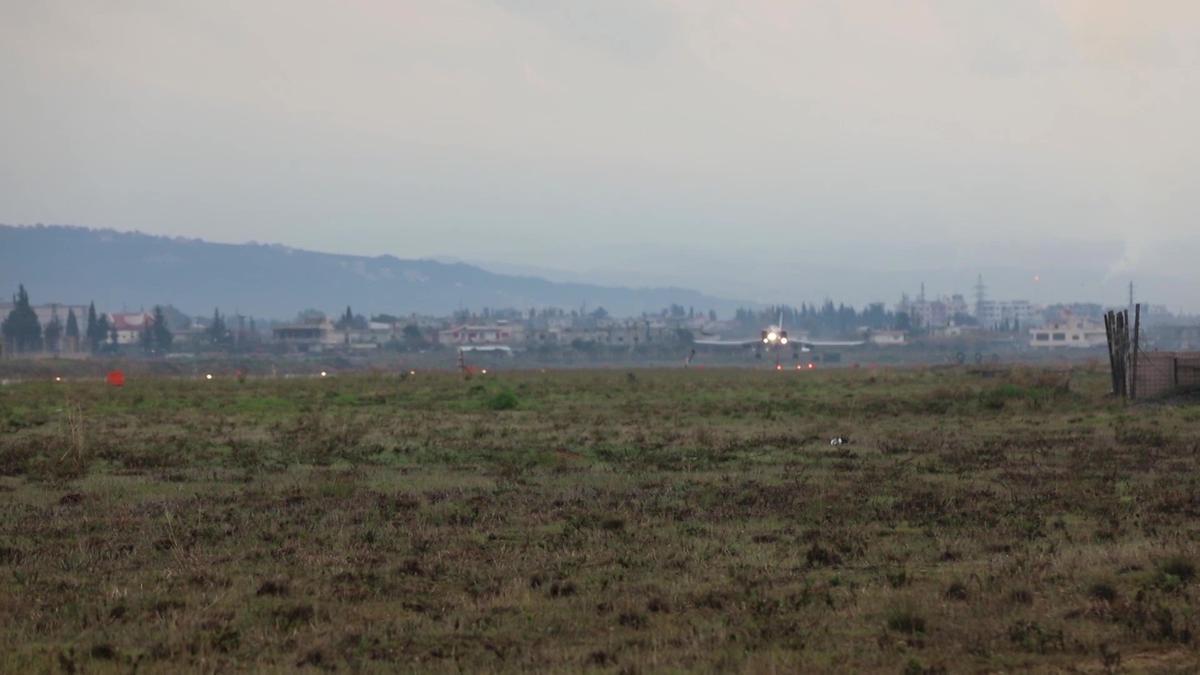
During the landing of one of the Russian planes, the populated areas adjacent to the base appear. Screenshot from a video by the Russian Ministry of Defence
Maan, an ear disease physician and a resident of the area surrounding the base, who did not reveal his full name for security reasons, points out: “Airport noise is associated with hearing impairment, high blood pressure, and cardiovascular disease. The relationship between aircraft noise and these diseases has been demonstrated in several case studies.”
The specialist adds that there is no research on the impact of air strikes on the population. The “noise causes many damages that do not occur directly, such as temporary hearing loss, but this issue accumulates over time until it often ends in a state of deafness and complete inability to hear.”
The World Health Organization has classified noise pollution as a type of environmental pollution because of its effects on humans in their natural state, that is, in a country not marred by acute military conflicts.
The strength levels of natural human sounds range from 30 decibels to 80 decibels (a unit of sound intensity), and their frequencies range from 20 Hz to 20,000 Hz.
Noise pollution from aircraft engines during take-off exceeds 120 decibels, which constitutes a high-pressure force that leads to hearing loss. In military combat planes, it exceeds that according to the strength and size of the aircraft. Issues such as sound are rarely noticed in the aircraft manufacturing process.
According to a WHO health report, 1.8% of heart attacks in Europe are caused by traffic noise greater than 60 decibels.
The previous dangers prompted the authorities in various countries to build airports in areas far from the population, at a distance of at least 30 kilometres.
Houses crack, and children panic
Some witnesses in the villages adjacent to the Hmeimim base indicate that cracks occurred inside their homes, which caused their prices to drop, and that some residents changed their areas of residence, especially with complaints of children being frightened by loud sounds.
Maha.kh., a mother of three children who lives in a village adjacent to the Hmeimim base, says that her children have lost focus on their studies; they wake up terrified because of the night raids.
“There is no way to get rid of this situation other than displacement, as long as the base constitutes a higher authority than the state and there is no way to complain or respond,” Maha says.
Doctor Maan confirmed that aircraft noise causes “sleep disturbance, decreased school performance, stimulation of aggression, and other antisocial behaviours”.
Some residents complained about the consequences of the base near them, as it was a target for the opposition forces. The inhabited surrounding area has been exposed to fireworks or missile debris.
There are also explosive projectiles that fall from Russian planes during take-off. A rocket fell next to a house in the village of Al-Sharasher but did not explode, according to previous reports. The residents were affected by the incident, when the competent authorities detonated both the missile and the house.
The base was subjected to at least two mass drone attacks during the first week of 2018, killing many individuals and damaging or destroying several aircraft.
The militarisation of the Base’s surrounding and the disruption of life
Outside the base, the Syrian intelligence side handles the perimeter affairs. The investigation monitored the extent of militarization in the region. Several witnesses indicate that the checkpoints and those in charge of them restrict the movement of residents and often prevent them from reaching their fields adjacent to the airport and the base, whether for unjustified security intent or extortion.
Ahmed Ali (a pseudonym, 36 years old), a government employee, says that the checkpoints near the airport and the base (which are adjacent) practice extortion. They impose royalties, whether from the farming seasons or by forcing them to secure some of their supplies, such as cigarettes and yerba mate adding that the requests for these members are “endless”.
This aspect is not limited to the requests of the checkpoint members but rather to a parallel restriction of the movement of agricultural vehicles and all accompanying work activities. The access paths to those fields were determined after they were mostly open.
Adeeb M., a farmer from the area, mentions that agricultural vehicles are being searched with explosives detectors, mines, and the like, and harvesting seasons are disrupted to achieve more extortion.
Adeeb continues to say that many merchants are now refusing to guarantee seasons as a result of the practices and requirements of the intelligence checkpoints, which has caused losses to the farmers of the region.
As for the Russians, they did not come out of their isolation except to fight. Dealing with the neighbourhood was limited to the fuel trade, in the interest of Russian officers, then the currency trade and the exchange of the ruble into dollars. Russian soldiers often shop for tobacco and alcohol, according to witnesses from the region interviewed by the investigation.
The owner of the Aurora store, which specializes in selling traditional souvenirs, says, “The Russians, at the beginning of their presence here, used to come in groups of three individuals and armed people.” Years later, the neighbourhood has not noticed their mixing with the people in the region.
Footage broadcast by the media (Russian and others) from inside the base indicates that it owns its own kitchens, market, and rituals and that contact with the surroundings is limited to shopping for logistical and food items through Syrian contractors who are subject to inspection.
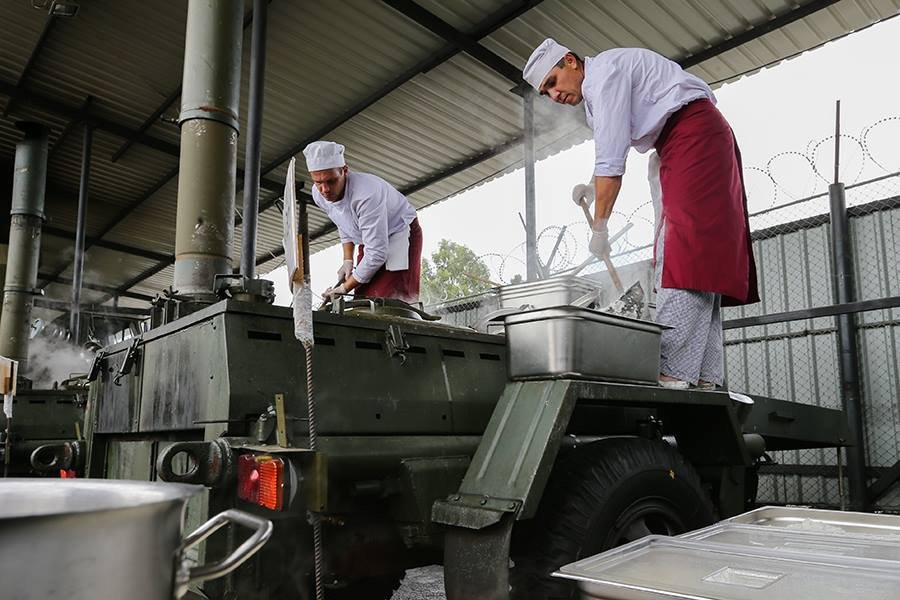
A mobile kitchen. Source: sdelanounas.ru
Hmeimim’s costs
The base includes more than 50 aircraft of various types and an unspecified number of soldiers.
An investigation by the Russian website newizv in 2018 estimated the number of Russian soldiers throughout Syria at around sixty thousand and nearly five hundred generals over the years of intervention since 2016.
The investigation estimates that a third of these officers and soldiers are from the military police spread in hot spots in Syria, government or military institutions in cities, and about forty thousand in the Hmeimim and Tartous naval bases. Accordingly, the number of Russians at the base is about twenty thousand.
With the war waged by Russia on Ukraine and the withdrawal of large numbers of soldiers and officers, no statistics are available on the size of the remaining forces in Syria.
According to estimates by RBC, which specialises in information technology, services, and media, the military operation in Syria cost the Russian Ministry of Defence at least $2.5 million per day in 2015.
The amount included payments to military personnel and civilian employees, costs for maintaining the infrastructure of the Hmeimim base and other expenses, as well as direct actions of aviation-air battles.
Expenses for personnel from the base soldiers and the naval base amounted to about $160,000 a day.
Based on these data, and taking into account the doubling of business and the number of soldiers in 2017, Novaya Gazeta Europe data team estimated the costs of Hmeimim’s maintenance and aviation business from start-up to August 2021, amounting to 364.5 billion rubles, which is equivalent to $5.16 billion.
There is no open-source information about the costs of rebuilding the base’s infrastructure, but according to the government publication RIA, which reported on the modernization of Belbek Airport in Crimea, Hmeimim was rebuilt according to a similar project with similar costs.
Based on this, it is assumed that the reconstruction of the Hmeimim air base has cost the Russian side no less than 1 billion rubles (about $14.2 million).
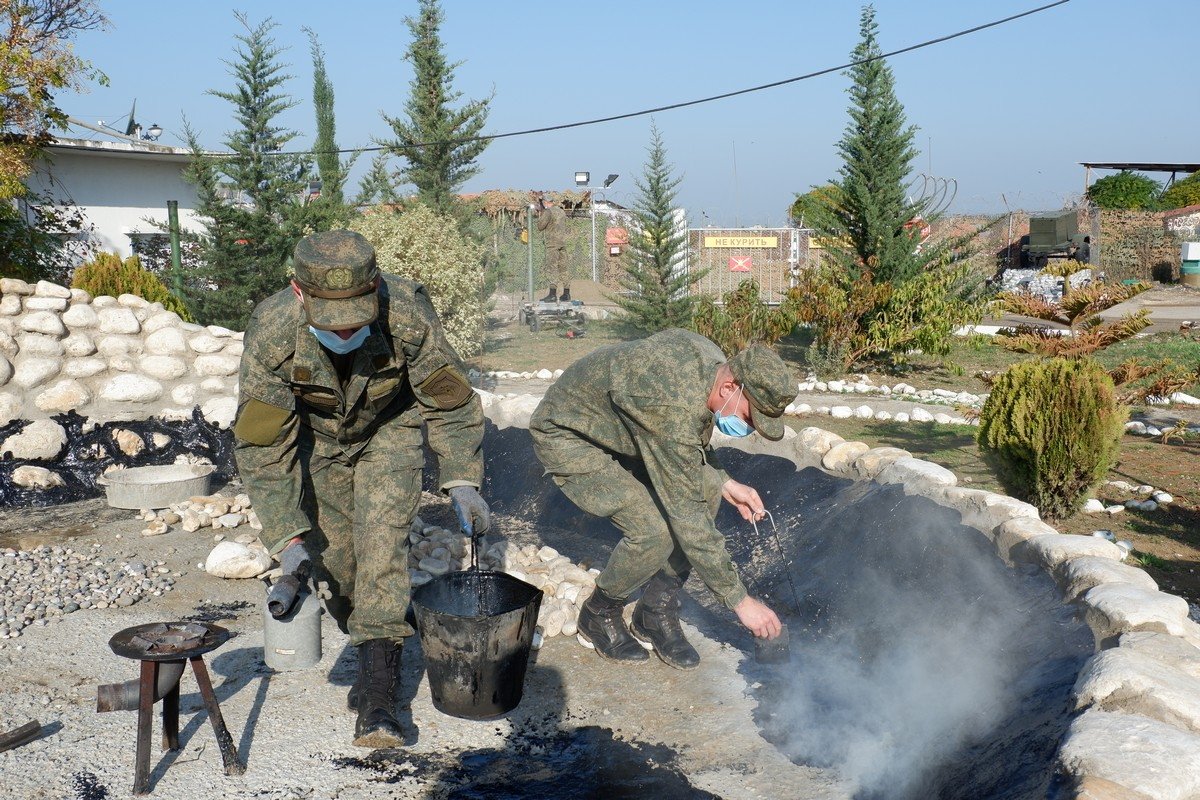
Two Russian soldiers tending a garden inside the Hmeimim base, 2 January 2020. Source: Russian Ministry of Defence
Join us in rebuilding Novaya Gazeta Europe
The Russian government has banned independent media. We were forced to leave our country in order to keep doing our job, telling our readers about what is going on Russia, Ukraine and Europe.
We will continue fighting against warfare and dictatorship. We believe that freedom of speech is the most efficient antidote against tyranny. Support us financially to help us fight for peace and freedom.
By clicking the Support button, you agree to the processing of your personal data.
To cancel a regular donation, please write to [email protected]
